DFW C.V (mid production)
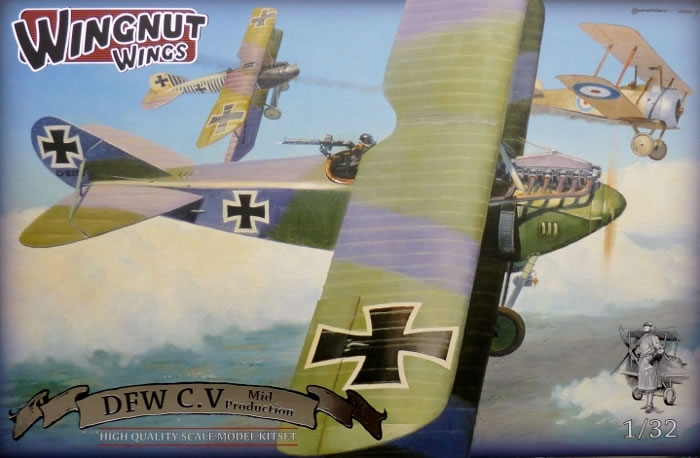
Wingnut Wings, 1/32 scale
| S u m m a r y |
Catalogue Number: |
Wingnut Wings Kit No. 32040 - DFW C.V (mid production) |
Scale: |
1/32 |
Contents and Media: |
16 sprues of grey plastic; three parts in clear; markings for five options; high quality instruction booklet with reference photos. |
Price: |
USD$99.00 with free shipping worldwide, available online from Wingnut Wings' website. |
Review Type: |
First Look |
Advantages: |
Well-formed plastic parts with excellent detail and no distortion; wings incorporating realistic washout and sharp scalloped trailing edges; useful fret of photo etched parts; excellent fit thanks to clever engineering; decal sheet in perfect register with stencil data, placards and instrument faces; instruction booklet with an abundance of reference photos. |
Disadvantages: |
|
Conclusion: |
Despite its sterling performance throughout the war, the DFW C.V hasn’t received the recognition in kit form that other lesser types have garnered. This release from Wingnut Wings goes a long way towards fixing this discrepancy. It’s another quality package that captures all the detail of the original design as well as the subtleties between the 4 different manufacturers. Thanks to clever engineering from WNW, everything comes together with a minimum of fuss. It’s another quality package from the “Land of the Long White Cloud”. |
Reviewed by Rob Baumgartner

HyperScale is proudly supported by Squadron
A main part of the DFW C.V’s success was due to the design’s strong but light airframe.
In early October 1916, the first examples reached the Front. They made such an impression that Idflieg ordered over 1000 examples. Underwriting quantity production on this scale was unprecedented, which showed great faith in the design.

Such numbers necessitated the use of contractors. Luft-Verkehrs-Gesellschaft (LVG), Aviatik, and Halberstadt all got in on the act.

Idflieg was justified in their decision. Reports came back from the Front saying that the type had good flight characteristics, and excellent performance. There was plenty of room in the observer’s cockpit with ample space for storing ammunition, bombs and photography equipment.
By war’s end, nearly 4000 aircraft were produced.
The first thing one notices is the bulging box.
It’s the standard size for a 2-seater but the sheer number of parts don’t quite fit inside the cardboard enclosure. Packed within are 16 sprues of various sizes, a fret of photo-etched parts, and a decal sheet for 5 interesting aircraft. As expected, there’s also the excellent instruction book that doubles as a mini reference source with its many period photographs.
All of the plastic items are beautifully moulded with no sign of distortion anywhere. The detail is as sharp as ever and any ejection pin marks are located out of sight on the finished model.
The engineering of these kits seem to get better and better with each release. A classic example is the bulkhead between the engine and pilot. There are many features on both sides that would be compromised if it were moulded in one piece. WNW have made it as two back-to-back halves that retain all the finesse of the original item.
The high parts count can be attributed to sprues H, I, J, and K. All are devoted to a specific licenced manufacturer which is testimony to the level of research that has gone into the type.
The plastic is a little softer than we are currently used to. To avoid a furry edge when cleaning up the seam lines, make sure you use a fresh scalpel blade. This plastic does have some advantages though. If it had been any harder, the intricate piping on the carburettor intake manifolds “O1” would have broken off on numerous occasions during the clean-up process.
Over 30 parts make up the well-appointed cockpit area. All of the usual suspects are present including the grease pump, starting magneto, ammunition, and empty belt container. Not forgotten are the 12.5kg PuW bombs (and rack), Telefunken Type C wireless set, aerial winder, 25 & 225 litre fuel tanks, and synchronizing gear.
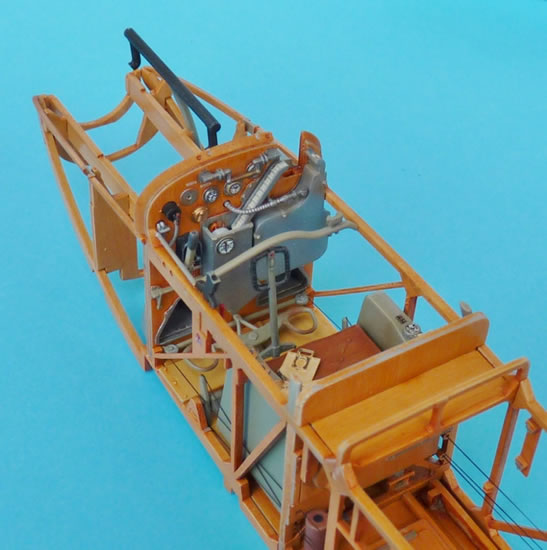
Various placards and instruments faces can be found on the decal sheet, with the latter looking most convincing under a coat of gloss varnish. The photo-etched fret makes an appearance here by suppling the pilot and observer’s lap belts. The attachment points are quite fragile so take care when bending them to achieve a more natural look.
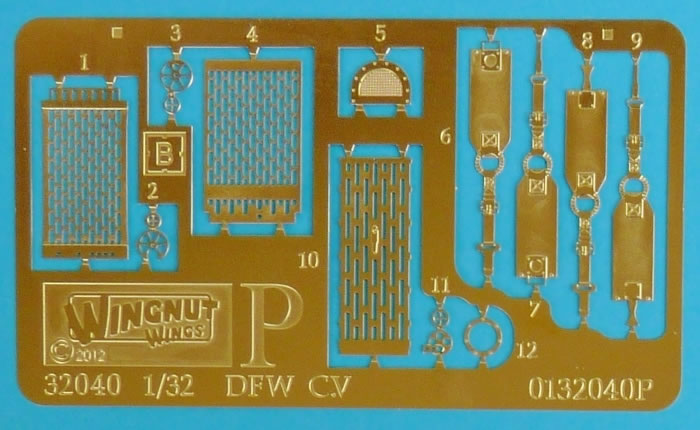
There are numerous holes that need drilling out on the airframe. Those chosen are dependent on which manufacturer is being replicated, and whether the IMG 08 or LMG 08/15 was fitted.
Speaking of machine guns, p-e jackets are supplied for each. This time, a plastic tool (rod) is provided to assist in rolling the metal to the correct diameter.
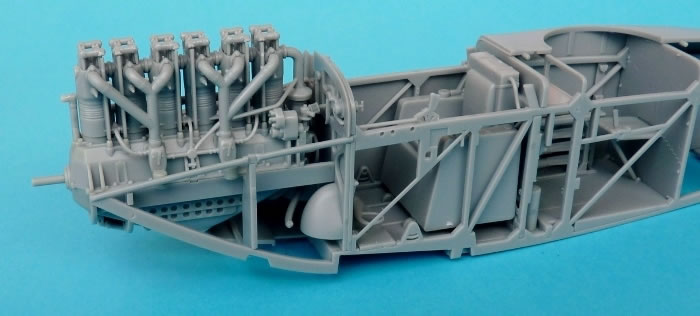
Sprue “E” contains a lovely 19 piece 230hp Benz Bz.IV engine. The cylinders have the pushrods already moulded on but there are alternates included where the modeller can add these separately.
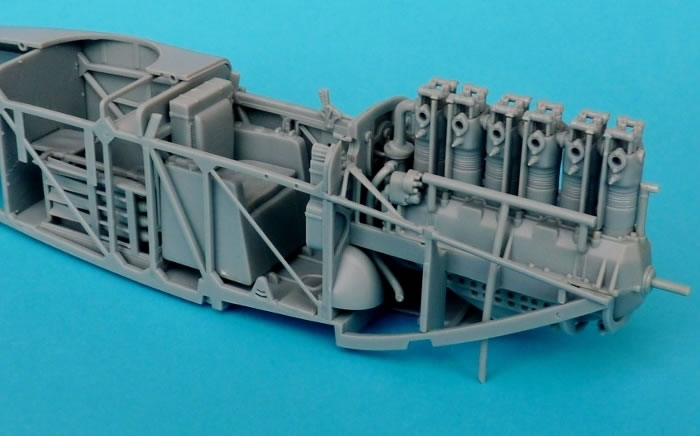
Despite the multifaceted interior, it all fitted nicely between the fuselage halves.
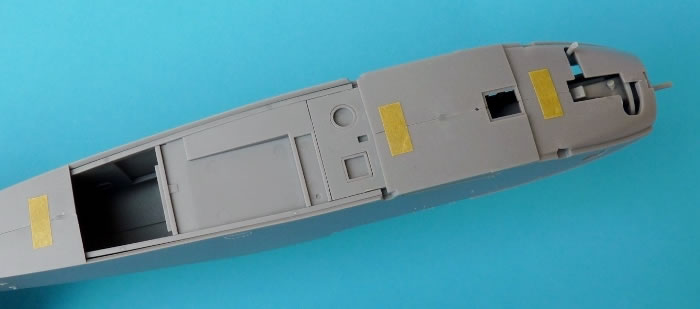
It’s when you add the engine and “winter” cowlings that you really appreciate the quality of the product. Close inspection of the louvres will reveal that they all have sharply defined openings which is a real credit to the engineering.
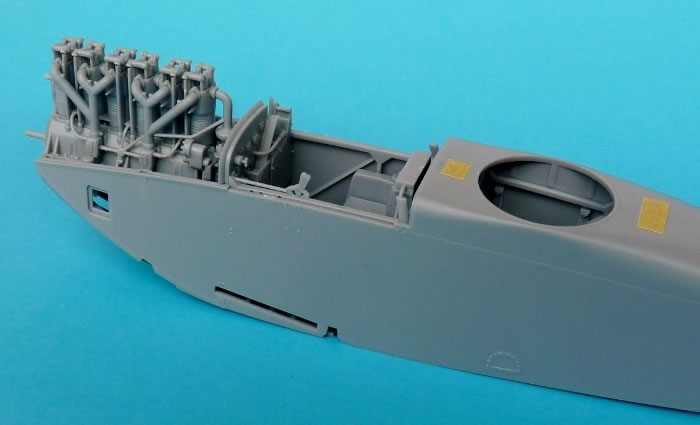
The wings are superb examples of moulding. There are no blemishes anywhere and they all exhibit sharp trailing edges and well defined rib detail. The ailerons are separate and correctly show the distinctive “washout”.
While the lower wings are moulded as single pieces, the upper flying surfaces are in two parts. Joining these together will require a strong join and so WNW adds an insert that sits flush with the underside. The neat fit means that very little filler is required for a seamless finish. Be careful not to sand off the leading edge stacking pads during the clean-up process.
The struts are keyed to fit snugly into their slots and with the top wing on, it’s quite surprising how sturdy the whole assembly is. The undercarriage fits equally well with tabs that insert deeply into the side of the fuselage. Note the engraved demarcation between the tyres and wheel covers which will greatly ease the painting process.
Choices of Astra, Wolff, or Wotan propellers are available, and we also get the strut mounted anemometer and wireless generator.
Sprue “G” provides a range of goodies including a selection of aerial cameras, first aid kit, homing pigeon box, barograph, and of course the ubiquitous toy bear. Similarly, there’s a number of flare pistols to choose from as well as a couple of ladders.
A rigging diagram leaves no doubt as to where the various cables should go and this is helped by pre drilled holes in the plastic itself.
Marking Options
Five very different schemes are supported on the large decal sheet. Consequently no modeller should be intimidated by the painting process. There’s something for every skill level.
-
DFW C.V (LVG) 5203/16, Habsheim, April to May 1917
-
DFW C.V (Av) 5920/16 “Red 6”. Kurt Weser?, FA (A) 275?, September 1917
-
DFW C.V (Av) 5927/16, Hans Huppertz & Friedrich Neumüller, FA 18, April 1917
-
DFW C.V “Grenade”, FA 48b, 1917 to early 1918
-
DFW C.V “Stripes”, FA (A) 282?, 1917 to early 1918
The decals were printed in perfect register and are surrounded by a minimum of carrier film. Apart from the individual aircraft markings, there’s a plethora of stencil data, placards, and of course the aforementioned dial faces.
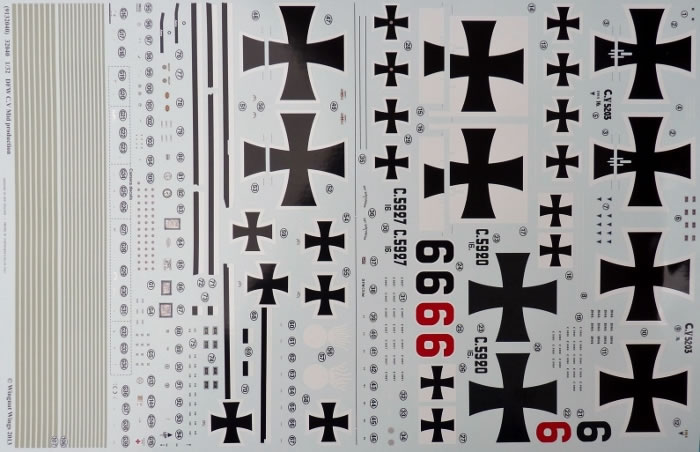
Setting solutions can be used but they are not really necessary. If you do decide to go down that path, stay away from the stronger formulas.
Wingnut Wings’ love affair with two seaters continues and this release easily matches the high standards of those before it.
The quality of the fit is excellent and the level of detail superb. The design is quite complicated in a number of areas but the kit’s engineering ensures the modeller is blissfully unaware of any issues.
There were a number of different contractors involved in the building of the C.V. As a result, each company introduced subtle changes to the design, something that is quite evident on the finished aircraft. WNW have done an admirable job of researching these differences to make sure their product is as accurate as possible.
It’s another worthy addition to the ever expanding range of these often neglected workhorses, and one that should be on the shelves of all aficionados.
Thanks to Wingnut Wings for the sample kit.
Review Text and Images Copyright © 2014 by Rob Baumgartner
Page Created 7 October, 2014
Last updated
9 October, 2014
Back to HyperScale Main Page

|
